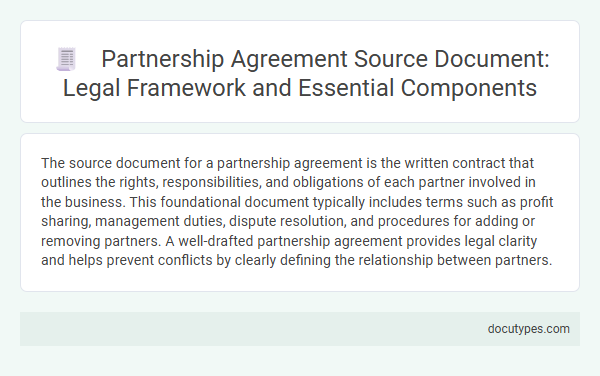The source document for a partnership agreement is the written contract that outlines the rights, responsibilities, and obligations of each partner involved in the business. This foundational document typically includes terms such as profit sharing, management duties, dispute resolution, and procedures for adding or removing partners. A well-drafted partnership agreement provides legal clarity and helps prevent conflicts by clearly defining the relationship between partners.
Introduction to Partnership Agreement Source Documents
| Introduction to Partnership Agreement Source Documents | |
|---|---|
| Definition of Source Document | The original document or set of documents used to create and formalize a partnership agreement, serving as the foundational legal record. |
| Common Source Documents |
|
| Purpose of Source Documents | Provide evidence of mutual consent, define roles, responsibilities, profit distribution, and dispute resolution mechanisms within the partnership. |
| Legal Importance | Source documents ensure enforceability of the partnership agreement and support compliance with jurisdictional business laws and regulations. |
| Examples of Source Documents by Jurisdiction |
|
Legal Framework Governing Partnership Agreements
The source document for a partnership agreement is the partnership deed, which outlines the rights, responsibilities, and obligations of each partner involved. This legal document serves as the foundation for regulating the partnership's operations and internal management.
Partnership agreements are governed by statutory laws such as the Uniform Partnership Act (UPA) or the Revised Uniform Partnership Act (RUPA) in the United States, which provide the legal framework for partnership formation and governance. These laws establish default rules that apply unless the partnership deed specifies otherwise, ensuring clarity and enforceability in legal disputes.
Key Elements of a Valid Partnership Agreement
The source document for a partnership agreement is a written contract that outlines the roles, responsibilities, and rights of each partner within the business. Key elements of a valid partnership agreement include the names of partners, capital contributions, profit and loss distribution, decision-making authority, and procedures for dispute resolution. Ensuring these components are clearly defined helps protect your interests and facilitates smooth business operations.
Types of Partnership Structures Recognized by Law
The source document for a partnership agreement outlines the terms, responsibilities, and operational framework between partners. It serves as a legally binding contract that governs the relationship and business activities of the partnership.
- General Partnership - A structure where all partners share equal responsibility for management and liabilities.
- Limited Partnership - Involves general partners managing the business and limited partners who invest but do not partake in daily operations.
- Limited Liability Partnership (LLP) - Provides partners protection from personal liability for certain partnership debts, combining features of partnerships and corporations.
Essential Clauses in Partnership Agreements
The source document for a partnership agreement is the written contract that outlines the terms and conditions agreed upon by the partners. This document serves as the legal foundation for the business relationship, detailing rights, responsibilities, and obligations.
Essential clauses in partnership agreements include capital contributions, profit and loss distribution, and management roles. Your agreement should also cover dispute resolution, duration of the partnership, and procedures for adding or removing partners.
Rights and Responsibilities of Partners
What is the source document for a partnership agreement outlining the rights and responsibilities of partners? The source document is the partnership agreement itself, which serves as a legally binding contract. This agreement details each partner's duties, financial contributions, profit distribution, and decision-making authority.
Capital Contributions and Profit Sharing
The source document for a partnership agreement primarily outlines the capital contributions made by each partner, detailing the initial investments or assets each party brings into the partnership. It also specifies the profit sharing ratios, establishing how earnings and losses will be distributed among the partners.
This document serves as the legal foundation governing the financial responsibilities and benefits of each partner. Capital contributions can include cash, property, or services and must be clearly valued to avoid disputes. Profit sharing clauses ensure transparency in how income is allocated, reflecting each partner's stake and agreed terms in the partnership.
Dispute Resolution Mechanisms in Partnership Agreements
The source document for a partnership agreement is the legal contract that outlines the rights and responsibilities of each partner. Dispute resolution mechanisms within this document specify how conflicts between partners will be managed and resolved to prevent prolonged litigation.
These mechanisms often include procedures such as mediation, arbitration, or buy-sell clauses designed to address disagreements efficiently. Clear dispute resolution clauses help maintain the partnership's stability and ensure continued business operations.
- Mediation Clause - Specifies a voluntary process where a neutral third party assists partners in reaching a settlement before escalating the dispute.
- Arbitration Clause - Establishes a binding decision-making process where an arbitrator reviews the dispute and renders a final resolution.
- Buy-Sell Provisions - Provide a structured method for partners to buy out interests of a withdrawing or disputing partner to avoid operational disruption.
Procedures for Amendment and Termination
The source document for a partnership agreement is the original written contract that outlines the terms and conditions agreed upon by all partners. Procedures for amendment typically require unanimous consent or a majority vote as specified within the agreement, often documented through formal written amendments. Termination procedures detail the process for dissolving the partnership, including settling debts, distributing assets, and notifying relevant authorities in compliance with state laws.
What Is the Source Document for a Partnership Agreement? Infographic

